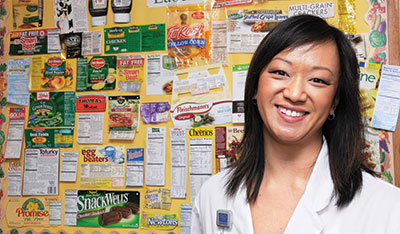Plagued by Plaque?
Eat Your Way to Better Heart Health

Cindy Liu, clinical dietitian
Heart disease is the leading cause of death in the United States, but there is some good news: A change in diet can raise the odds in your favor.
That’s easier said than done, admits Cindy Liu, clinical dietitian at NorthBay Healthcare. Foods you’ve enjoyed your whole life are suddenly the Public Enemy No. 1 and reading labels and counting milligrams of sodium becomes part of daily life.
But that’s why she’s here—to help patients figure out how to navigate and manipulate their daily menus into more heart-healthy choices.
“By the time I see the patient, they’re recovering from a heart event, and they’re still in a state of shock. No one plans to have a heart attack,” she says. “We talk about what kinds of foods they need to incorporate in their diet and strategies for success. Sometimes, if they participate in our cardiac rehab program, I get to meet with them again and make sure they’re on the right path.”
The most difficult thing to change, says Cindy, is their mindset. “For some people, it’s a foreign concept. They are used to eating fast food and haven’t incorporated a lot of fruits and vegetables in their diet. Food is also nostalgic, especially during the holidays. It’s hard to give up those favorite pies or cookies.”
If you look at food as fuel, it becomes easier to unemotionally deal with the concept, she notes. “Unfortunately, food is more than fuel to most people. It’s emotionally and psychologically challenging.”
Studies have shown that exercise and a change in diet can make a huge difference for patients with coronary artery disease. That’s what happens when plaque (fatty substances such as cholesterol) build up in the arteries and slow or block the flow of blood. Called atherosclerosis, it can lead to heart attacks and death.
A diet high in saturated fat and cholesterol can raise your cholesterol levels. Cindy urges patients to be careful with processed foods, such as frozen dinners. They can be high in fat, sugar, salt and cholesterol, even if they promise “healthy” options on the box.
Choose lots of fresh or frozen fruits and vegetables, lean meats and fish, and whole grains, such as oats and whole wheat, she advises. Choose unsaturated vegetable oils, such as canola oil instead of saturated fats like butter.
“When I tell people about the heart-healthy diet, I try not to use the word diet. It’s more of a way of living,” she says.
Salt Shockers
Trying to stay within the daily recommended limit of 1,500 mg or less of salt a day? A quick peek at nutrition labels can reveal surprisingly high sodium levels on some favorite foods:
- Frozen Turkey and Gravy TV dinner = 787mg
- One cup of vegetable juice = 479mg
- Two slices of salami = 362mg
- One tablespoon of soy sauce = 1,024mg
- One tablespoon of ketchup = 167mg
- One-quarter cup of canned jalapeños = 568mg
- One ounce of pretzels = 385mg
- One-half cup of spaghetti sauce = 554mg
- McDonald’s Big Breakfast + Hot Cakes = 2,150mg
- Wendy’s Baconator hamburger = 1,850mg
